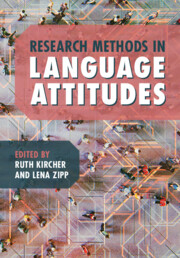Book contents
- Research Methods in Language Attitudes
- Research Methods in Language Attitudes
- Copyright page
- Contents
- Figures
- Tables
- Contributors
- Foreword
- Acknowledgements
- 1 An Introduction to Language Attitudes Research
- Part 1 Analysis of the Societal Treatment of Language
- 2 Discourse Analysis of Print Media
- 3 Content Analysis of Social Media
- 4 Discourse Analysis of Spoken Interaction
- 5 Analysis of Communication Accommodation
- 6 Variable Analysis
- Part 2 Direct Methods of Attitude Elicitation
- Part 3 Indirect Methods of Attitude Elicitation
- Part 4 Overarching Issues in Language Attitudes Research
- References
- Index
- References
2 - Discourse Analysis of Print Media
from Part 1 - Analysis of the Societal Treatment of Language
Published online by Cambridge University Press: 25 June 2022
- Research Methods in Language Attitudes
- Research Methods in Language Attitudes
- Copyright page
- Contents
- Figures
- Tables
- Contributors
- Foreword
- Acknowledgements
- 1 An Introduction to Language Attitudes Research
- Part 1 Analysis of the Societal Treatment of Language
- 2 Discourse Analysis of Print Media
- 3 Content Analysis of Social Media
- 4 Discourse Analysis of Spoken Interaction
- 5 Analysis of Communication Accommodation
- 6 Variable Analysis
- Part 2 Direct Methods of Attitude Elicitation
- Part 3 Indirect Methods of Attitude Elicitation
- Part 4 Overarching Issues in Language Attitudes Research
- References
- Index
- References
Summary
This chapter outlines how the discourse analysis of print media can be used to examine language attitudes and discusses the main strengths and limitations of this method. One significant strength lies in the fact that the printed press is an important means by which ideas about language are (re)produced. Analyses of the metalanguage used in the press can therefore be particularly revealing about language attitudes in a given society. An example of a limitation is the fact that print media texts vary enormously in terms of their context and audience. This makes a restricted practice of discourse analysis problematic, but equally too broad a practice may become effectively meaningless. The chapter provides an overview of the main discourse analytical approaches that have been applied to language attitude studies, and then narrows the focus to examine critical discourse analysis (CDA) in particular, outlining its strengths and limitations, giving examples of how it can be used to analyse and interpret data, and discussing key practical issues in planning and designing CDA research. The chapter concludes with a case study evaluating attitudes towards French using a corpus of language columns in French newspapers, thereby exemplifying the main points made in the chapter.
Keywords
Information
- Type
- Chapter
- Information
- Research Methods in Language Attitudes , pp. 19 - 34Publisher: Cambridge University PressPrint publication year: 2022
References
Suggested further readings
Accessibility standard: Unknown
Why this information is here
This section outlines the accessibility features of this content - including support for screen readers, full keyboard navigation and high-contrast display options. This may not be relevant for you.Accessibility Information
- 3
- Cited by
